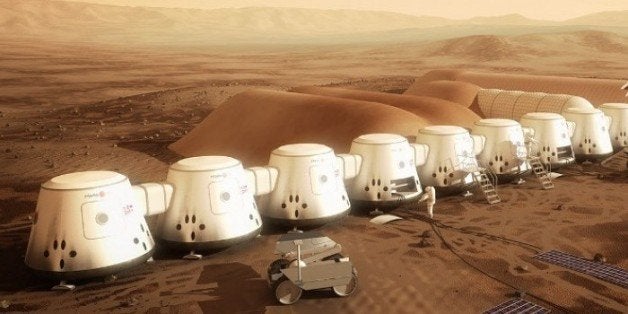
Thinking of joining the Mars One mission to establish a permanent colony on the red planet? Here's something to consider before signing on the dotted line: a new computer simulation by students at MIT shows that the colonists would likely face a range of deadly problems, including starvation and suffocation.
"We found many problem areas, many of which revolve around the current capability of state-of-the-art technologies," Sydney Do, a doctoral student in aeronautics and astronautics at the university and one of the students behind the simulation, told The Huffington Post in an email. "These problems in turn impact the long-term sustainability of the Mars One Plan."
What exactly did the simulation show? For starters, oxygen given off by the colony's crops would build up--raising the risk of fires and placing structural stress on the habitat. The habitat would automatically vent excess gas into space, but eventually the colony's nitrogen tanks would be depleted. That would make it impossible to sustain sufficiently high air pressure within the habitat, and the colonists would suffocate.
"This was not something that we were expecting to see," Do said, "as this sequence of events is quite unintuitive."
The simulation also suggests that it would be cheaper and safer for colonists to bring food with them rather than grow their own, as envisioned by Mars One.
"Bringing food along would remove any issues with crop-derived excess oxygen consumption, and any risks with sub-optimal growth yields and crop failure," Do said in the email, adding that crop failure could cause the colonists to starve.
The simulation also showed that the cost of delivering the spare parts essential to the colony would be prohibitive--the simulation's most important finding, according to Do.
What does Mars One have to say about the simulation?
Mars One CEO Bas Lansdorp defended the mission, telling The Huffington Post in an email that the students had taken some of its planning documents "a bit too literally." But he didn't dismiss the criticisms out of hand.
"While we disagree with their conclusions on oxygen...we do agree with them that it is important to assess the spare part strategy of the outpost very carefully," he said in the email. "This is something that Mars One will assess very carefully in the eight years that our teams train in a copy of the Mars outpost here on Earth."
But Do clearly believes that a lot of work needs to be done to give the mission a good shot at success. So does Dr. Olivier de Weck, a professor of aeronautics and astronautics and engineering systems at MIT.
“We’re not saying, black and white, Mars One is infeasible,” de Weck said in a written statement. “But we do think it’s not really feasible under the assumptions they’ve made. We’re pointing to technologies that could be helpful to invest in with high priority, to move them along the feasibility path.”
The Mar One mission calls for a permanent colony to be established on Mars in 2025. More than 200,000 people applied for the one-way mission, with several hundred finalists still in the running.

